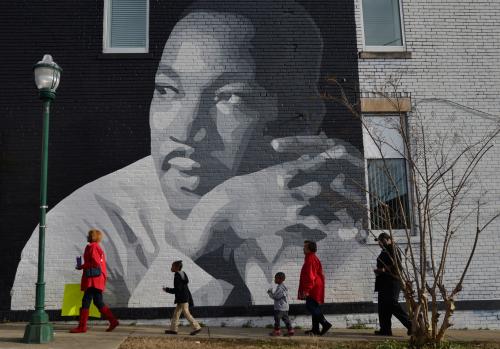When it comes to black employment, more credit for improvement should go to the very persons holding and hiring for the jobs. Notwithstanding the improving national unemployment rates, structural racism still precludes erasing employment disparities between racial groups. We should celebrate all people’s contributions to a robust economy, but we should not allow improvements in the aggregate to hide inequality behind the numbers.
After being in office for a year, Trump is claiming the lowest African American unemployment rate ever as a result of him being in office. The fuller picture shows that unemployment among blacks has been declining since the early Obama years. However, blaming one’s predecessor for bad employment numbers while accepting signs of growth is a presidential tradition of sorts; and at 6.8 percent, Trump has squatters’ rights on the lowest unemployment rate since the federal government started calculating the metric in 1972.
Nevertheless , there are certainly other people in specific places who deserve substantial credit for black employment. Instead of looking at national unemployment averages, which can mask geographic inequities, a look at cities’ individual employment rates offers another perspective on where credit for putting people to work should be given. Notwithstanding the broader macroeconomic forces that impact the flow of goods and services nationally, we can get a sense of how fertile and equitable a local economy is by examining cities’ employment profiles.
In this series on black cities we are concerned with locating assets for future investment. The local economy should be viewed as an asset that employers, investors and black workers can build upon for inclusive growth and prosperity.
Data from the American Community Survey 2015 5-Year Estimates* shine some light on which black cities have employment milieus that are more conducive to black employment. For majority black cities with available data, we compared the black population/employment ratio among majority black places for large (>50,000), medium (2500-49,999) and small (<2500) cities. The large and medium sized cities were mapped to get a sense of where in the country higher concentrations of black people are working.

Findings from our analyses of cities’ black employment/population ratio echo those in our black incomes report. Employment conditions seem to be better in Maryland, which has numerous cities within the top tier of the small, medium, and large categories. Bowie, Md. and Waldorf, Md. (both Washington, D.C. suburbs) top the large black city category. However, cities in Southern Florida, metro Atlanta, metro Cleveland, and metro Dallas also are also conducive to black employment. These cities show that when black workers are presented with opportunities, unemployment differentials exceed national averages.
The top ten large black cities with the highest black employment ratios are as follows:

For a complete listing of all majority black cities and their black employment/population ratios, click here.
An aside: Trump has repeated the statistic on black unemployment numerous times without citing the disparity between white (3.7) and black unemployment rates (6.8). The discourse on full employment (<5 percent unemployment rate) and black unemployment improvement not only mask severe racial disparities in employment in different cities, it accepts social inequality as a given. Trump’s simple focus on improved black unemployment is a distraction from structural racism that drags black employment.
Trump’s simple focus on improved black unemployment is a distraction from structural racism that drags black employment.
Touting numerical improvements in the aggregate tacitly deemphasizes the work on structural inequality that is still needed in order to remove inequalities and encourage inclusive economic growth. Cities must continue their much-needed efforts to provide minority entrepreneurs’ access to capital, improve public school options for low-income families, increase workforce development programs, and create inclusive zoning practices for affordable housing. In addition, give credit to black workers for disproving stereotypes that suggests they are the reason for unemployment disparity.
Getting to work
The physical access to jobs–transportation–is strongly connected to employment rates in that not having sufficient means to get to work effectually limits job options. Efficient transportation also maximizes the money one makes from employment. Consequently, public transportation is vital for low-income workers and for employers who need human capital.
We included in our examination of jobs a measure of the proportion of the black workforce that takes public transportation to work. In our efforts to track assets in majority black cities, an examination of transportation systems is warranted because it churns employment as well as other quality of life measures. Nationally, majority black cities on the East Coast have generally higher concentrations of the black workforce using public transportation, with notable exceptions in very large cities (Atlanta, Miami).

There is a wide range in the percentage of black workers who use public transportation among the various majority black cities. For instance, 38 percent of black workers use public transit in Washington, D.C., compared to 10 percent in Detroit.

Many cities with a large black workforce percentage that uses public transit have lower employment rates. However, there is some overlap between high employment and high public transportation usage. Large black cities that ranked in the top 20 on both measures include:
- Bowie, Md.
- Waldorf, Md.
- East Orange, N.J.
- Irvington township, N.J.
- Mount Vernon, N.Y.
- North Miami, Fla.
- Miami Gardens, Fl.
- North Charleston, S.C.
When black people are presented opportunities, they work. Who should take credit for employment should never move too far from the person actually doing the work and the employers who hire them. Presidents help shape markets and conditions that are good for business. But to be clear, many presidents have also created conditions that cast perpetual inequality as well. Who’s taking credit for that?
Note: The American Community Survey provides data regarding many types of transportation, including driving, carpooling, walking, and more. For a detailed breakdown of how black workers in black cities are getting to work, click here. Information for methods other than public transportation can be found in hidden columns.







Commentary
Who deserves credit for African American employment?
February 1, 2018